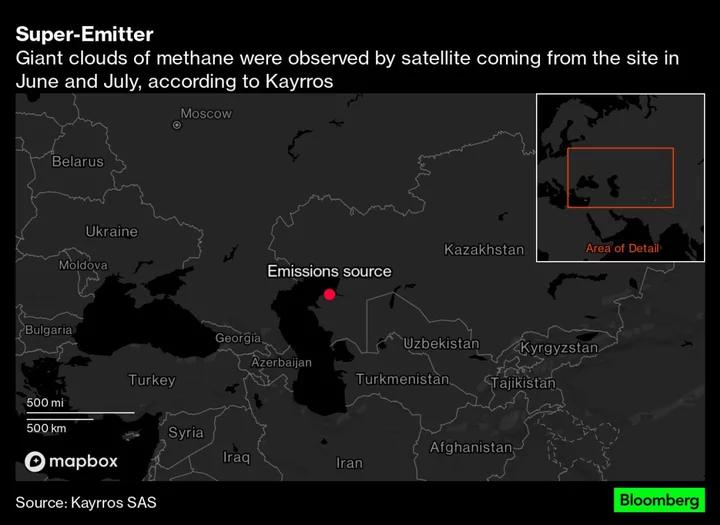A natural gas well blowout in a remote region in Kazakhstan has triggered a huge methane leak, scientists say, showing the risks of prospecting for fossil fuels.
Satellites observed giant clouds of methane spewing from the site at least nine times in the month leading up to July 23, French geoanalytics firm Kayrros SAS said. Its findings were broadly corroborated by scientists at SRON Netherlands Institute for Space Research.
The Kazakh explorer developing the well, Almaty-based Buzachi Neft LLP, confirmed in an emailed statement Aug. 1 there was an accident at exploration well No. 303 in the Karaturun Vostochny gas field in eastern Kazakhstan on June 9, and said the site has been burning continuously since then. However, it claimed satellite images likely show hot vapor clouds with minimal traces of the greenhouse gas.
The Kazakhstan Ministry of Energy didn't respond to a request for comment.
Scientists who use satellite observations to track greenhouse gas emissions disagreed with Buzachi Neft’s assessment.
“It is extremely unlikely to mistake water vapour for methane on multiple images captured by two hyperspectral satellites, whose very high spectral resolution leaves little doubt about the nature of the gas observed,” Kayrros said in a statement. Hyperspectral satellites collect data across the electromagnetic spectrum.
At least two satellites — the European Space Agency’s Sentinel-5P and the Italian Space Agency’s Prisma— have observed the plumes. Sentinel-5P’s spectrometer was designed specifically to detect methane.
Although Buzachi Neft said that the fire was combusting the leaking gas, satellites have previously observed significant methane plumes coming from blowouts and even dedicated flare stacks that mix the fuel with oxygen with the aim of combusting the gas into carbon dioxide.
Kayrros estimated emission rates from the site ranging between 35 and 107 metric tons of methane per hour based on the satellite detections. If that’s accurate, then the methane spewing continuously from this site since June 9 has inflicted the same short-term climate damage as the annual emissions from roughly 814,000 US cars at the lower end of the range and 2.49 million cars at the top end. The geoanalytics company said it was likely the worst methane leak attributable to a single source this year.
Read More: Orbiting Methane ‘Speed Cameras’ Are Catching Polluters in the Act
SRON said the mean emissions rate from methane plumes it attributed to the incident using observations from the Sentinel-5P satellite was about 100 metric tons of methane an hour. Of the approximately 1,200 methane plumes the group has detected so far this year globally, only 10% have exceeded 100 tons an hour.
Satellites detect concentrations of methane from space by analyzing the way sunlight reflects off the Earth. As light passes through a cloud of the gas, its intensity is weakened on certain wavelengths. Methane absorbs light in the short-wave infrared portion of the electromagnetic spectrum.
Methane is the primary component of natural gas and has a devastating impact on the climate because its warming power is more than 80 times that of carbon dioxide during its first 20 years in the atmosphere. As the planet rapidly warms triggering extreme weather events from wildfires to heat waves, countries are getting more serious about tracking and halting avoidable leaks of methane in what could be one of the most powerful steps to slow global warming.
Both the European Union and the US are working on new rules that are intended to limit methane emissions and some 150 countries have joined the Global Methane Pledge, an initiative that aims to reduce global releases of methane 30% by the end of this decade. Although Kazakhstan isn’t a signatory, the nation signed a memorandum of understanding with the European Bank for Reconstruction and Development in September to work towards joining the pledge.
Read More: A Cheap Fix to Global Warming Is Finally Gaining Support
The epicenter of the fire in Kazakhstan is blazing at about 650C, burning natural gas leaking from the site and generating steam from water, Buzachi Neft said. The company said in a statement sent to Bloomberg on July 31 that the site was spewing about 12,000 cubic meters of natural gas a day.
Buzachi Neft, its contractor which drilled the well, Zaman Energo Ltd, several other companies and the Ministry of Emergency Situations are pooling efforts to seal the leak.
Workers are drilling two directional relief wells that they hope can divert the gas to controlled flares, the exploration firm said. There are also plans to flood the blowout with water to stop the flow of gas and allow workers to seal it. That work will be carried out this month and is expected to be completed by Sept. 1, it added.

